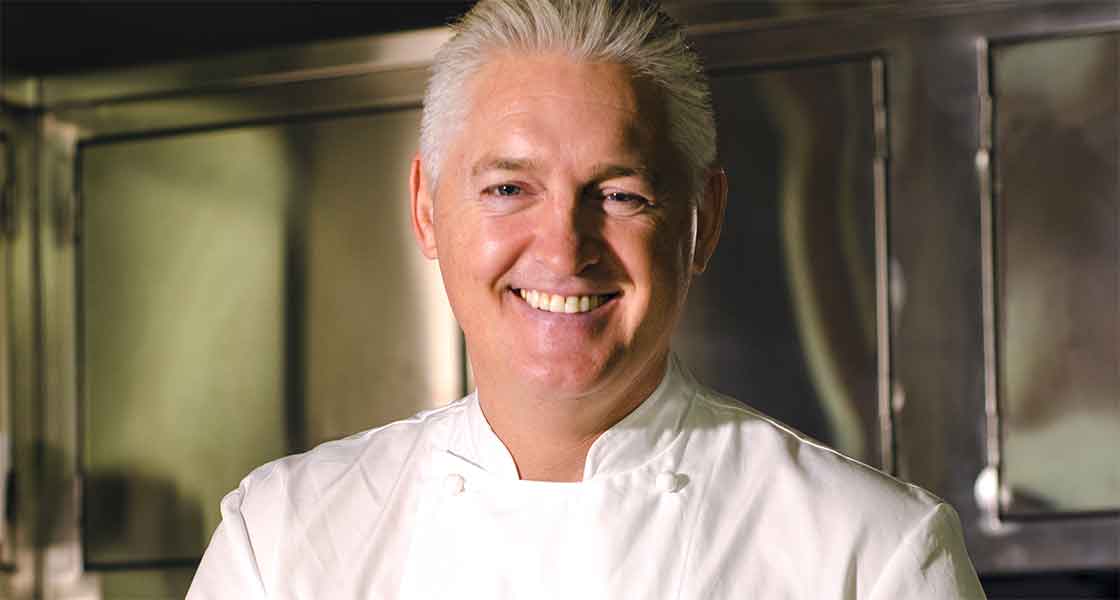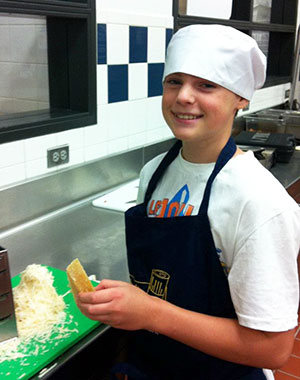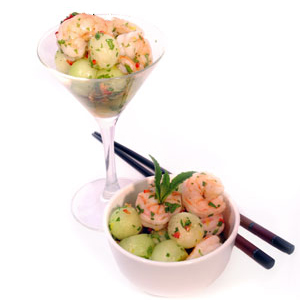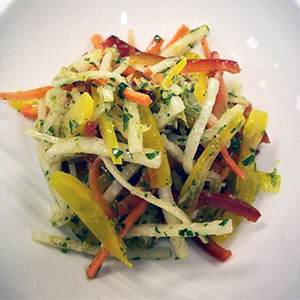Chef Mark Allison: Changing the Nutrition Conversation
CULINARY POINT OF VIEW
As the first director of culinary nutrition for the Dole Nutrition Institute (DNI), Mark Allison hangs his chef whites next to lab coats and lines his cookbooks up next to scientific journals. He collaborates with plant, food, and nutritional scientists at DNI and the North Carolina Research Campus to blend scientific findings with culinary arts to motivate the public to cook healthier meals. His goal is to move the food conversation away from what you shouldn’t eat to focus on what you should be eating—more fruits and vegetables.

Kelly Hensel: You held executive chef positions at some restaurants after graduating from school. What led you to return to school to study culinary arts and business administration and eventually turn to being a culinary educator?
Mark Allison: So, when I left school at 16 I had the choice of working at the shipyards, the coal mines, or the car factory. I had always enjoyed cooking at home with my mother, so I decided to become a chef. I went to work as a chef at a four star hotel for a few years and then worked abroad for a while. I was 24 when I returned to England and I realized that if I really wanted to make a career out of this, I needed to get an education.
I went to night school and did five years of culinary qualifications. By then I was running two fine dining restaurant and I had begun to think that it would be nice to get into something where I could still cook but have a bit more time off. I enjoyed teaching so I starting teaching part-time at a culinary school. It was a great way to keep cooking and to teach culinary skills to others. I ended up getting a certificate in education and then I decided that it would be a good idea to get a business degree if I wanted to grow into a position of being an administrator. By the time I completed my MBA I was 34 years old, married with two children, and was a full-time teacher.
 Hensel: How did your son’s diagnosis with type 1 diabetes affect your approach to food and cooking?
Hensel: How did your son’s diagnosis with type 1 diabetes affect your approach to food and cooking?
Allison: In 1998, I was offered a Fulbright teacher’s exchange program to come to America—specifically Anchorage, Alaska. My sons were two [years] and eight months when we went over. When Matthew was 14 months he became ill. We went to the doctor who said it was just a bad case of flu. About a week later, he wasn’t getting any better and my brother who is a type 1 diabetic told me to get Matthew’s blood tested. So we went back to the doctor and we refused to leave her room until she tested his blood. Well, they tested his blood and within 30 minutes he was in intensive care.
We went through a whole life change then. We used to eat relatively healthy anyway, but we knew that we would have to change our dietary habits to an even healthier lifestyle. That was really the catalyst that started us into eating healthy. Matthew has been great ever since. He’ll be 18 in December and he plays lacrosse and runs cross country.
Hensel: Type 2 diabetes is a growing problem, especially among children, in the United States. What, in your opinion, needs to be done to address the epidemic?
Allison: I think first and foremost cooking is a life skill and it should be taught in every school in the country. We also need to look at what people eat on a day-to-day basis because it’s really the food on their plate that is going to decide their long-term health. Most of the illnesses these days—heart disease, cancer, obesity—it’s all about the food that we’re putting into our bodies. And it’s not so much counting calories; it’s more the quality of the food that we actually digest. We need dense, rich, whole foods. And really the only whole foods that are on the planet are fruits and vegetables.
Hensel: Can you talk about your new job as Dole Foods’ culinary nutrition director??
Allison:I started in May. It’s a newly created position that basically encompasses everything that Dole wants to promote—recipe development, training chefs, and getting out into the community to teach people how to eat right. It also involves working with the scientists on campus [North Carolina Research Campus]. They do all the scientific work on breaking down the nutrients in all of these whole foods. And then I am given the opportunity to come up with easy recipes that people at home can use to increase their consumption of fruits and vegetables. My main job is to come up with recipe development for Dole and get people to eat more fruits and vegetables. I am already trying to work with the local schools and hospitals to promote healthy eating.
I hope to build a community outreach school where we can work with local chefs to develop their skills and where we can do summer programs to get kids in the kitchen. In the long term, we just hope to build on that. We want to be seen as a provider of education for people who want to learn more about healthy eating.

Hensel: How are you working with the scientists at the NC Research Campus? What’s your role with them?
Allison: They’re basically breaking down all of these fruits and vegetables to find out which ones have the best nutritional components. I’m given the task of putting these fruits and vegetables into easy-to-follow recipes that people at home can use.
It all comes back to education. You can walk into the local supermarket and there’s like 200 varieties of fruits and vegetables. But people tend to buy the same things—apples, oranges, maybe some broccoli. Nobody’s looking at some of the exotic fruits and vegetables because they don’t know what to do with them. People also talk a lot about how fruits and vegetables are expensive. Well, they can be if you end up throwing them into the trash after a week because they just sat in the fridge. Part of my goal with Dole is to try to make cooking fruits and vegetables simple for everybody. I want to get people to actually cook the food that they’re buying in the supermarket instead of just looking at it and thinking, “Well, this looks beautiful but I don't know what to do with it.”
So the scientists are coming up with all of this scientific information to actually say that fruits and vegetables are the best source of food on the planet, and it’s up to me to try and get customers to use the fruits and vegetables in the best, nutritious ways they can.
Hensel: Are the recipes on Dole’s website, or are they going to be in a cookbook of some sort?
Allison: We are still in the early days, but hopefully we are going to work with some of the R&D chefs at supermarkets and come up with recipe cards that you can pick up while shopping. Also, a lot of the recipes will be on the Dole website. And I am actually working on a children’s cookbook. We’re also hoping to put together some educational videos that we can get out to hospitals and schools so that people can watch how easy it is to make nutritious food.
Hensel:You have received a number of awards and achievements in your career. Is there one that you are most proud of and why?
Allison: The one I most proud of is probably the American Diabetes Association Father of the Year in 2012. I used to be on the board of the JDRF—the Juvenile Diabetes Research Foundation—and I did a lot of demonstrations for them. Also, as a father of a diabetic and two other sons, I believe all of us have benefited from having a healthy lifestyle and eating nutritious food. So, to me, that was probably the nicest, most personal award that I've ever received.

Melon & Shrimp - by Chef Mark Allison
Serves four
Ingredients:
- 2 garlic cloves, peeled and crushed
- 1 tbsp organic honey
- 2 tsp nam pla (Thai fish sauce)
- 1 lemon, juice and zest of
- 2 limes, juice and zest of
- 2 Thai red chilies, finely diced
- 1 cup cooked and shelled shrimp
- 1 tbsp raw almonds, lightly chopped (optional)
- 1 small cantaloupe melon, peeled and chopped into 1-inch dice (or use a melon baller)
- 2 tbsp freshly chopped cilantro
- 1 tbsp freshly chopped mint leaves
Method
- In a large bowl, combine the garlic, honey, nam pla, lemon juice, zest, lime juice, zest and chilies.Fold in the shrimp and almonds, add the melon and stir to combine. Cover with plastic, and place into the refrigerator to infuse the flavors for at least 1 hour.
- To serve, sprinkle over chopped cilantro and mint.

Sunset Slaw- by Matthew Allison
Serves four to six
Ingredients:
- ¼ tsp cajun seasoning
- ¼ tsp red pepper flakes
- ¼ tsp cumin seed
- 1 tbsp honey
- 2 limes – zest and juice of
- ¼ cup of extra virgin olive oil
- 1 carrot, washed, dried and cut into fine strips
- 1 small jicama, washed, peeled and cut into fine strips
- ½ red pepper, seeds removed, cut into fine strips
- ½ yellow pepper, seeds removed, cut into fine strips
- ¼ cup sun dried tomatoes, roughly chopped
- 1 red Thai chili pepper, cut into fine dice
- 1 tbsp freshly chopped cilantro
Method
- Place the Cajun seasoning, red pepper flakes, cumin, and honey into a large bowl. Add the zest and juice of the 2 limes. Whisk in the oil.
- Add the remaining ingredients and mix together well, cover with plastic, and place into the refrigerator to infuse the flavors for at least 1 hour. Allow to come to room temperature before serving.


